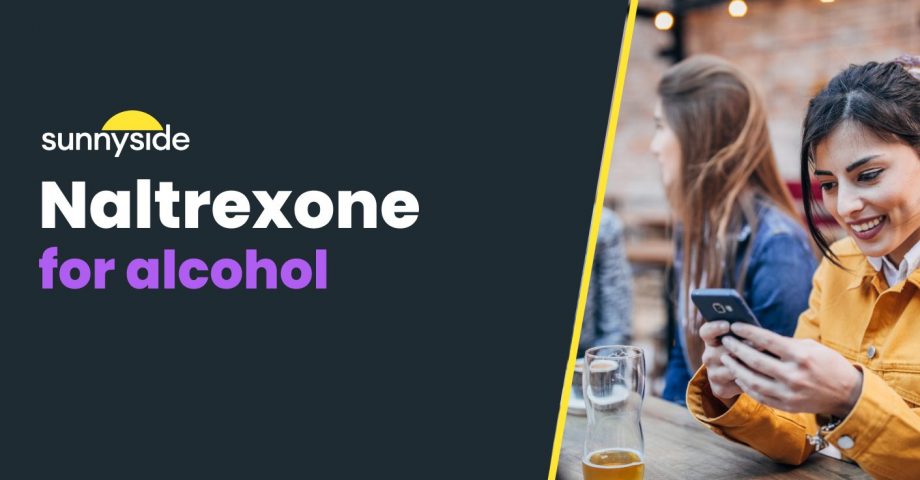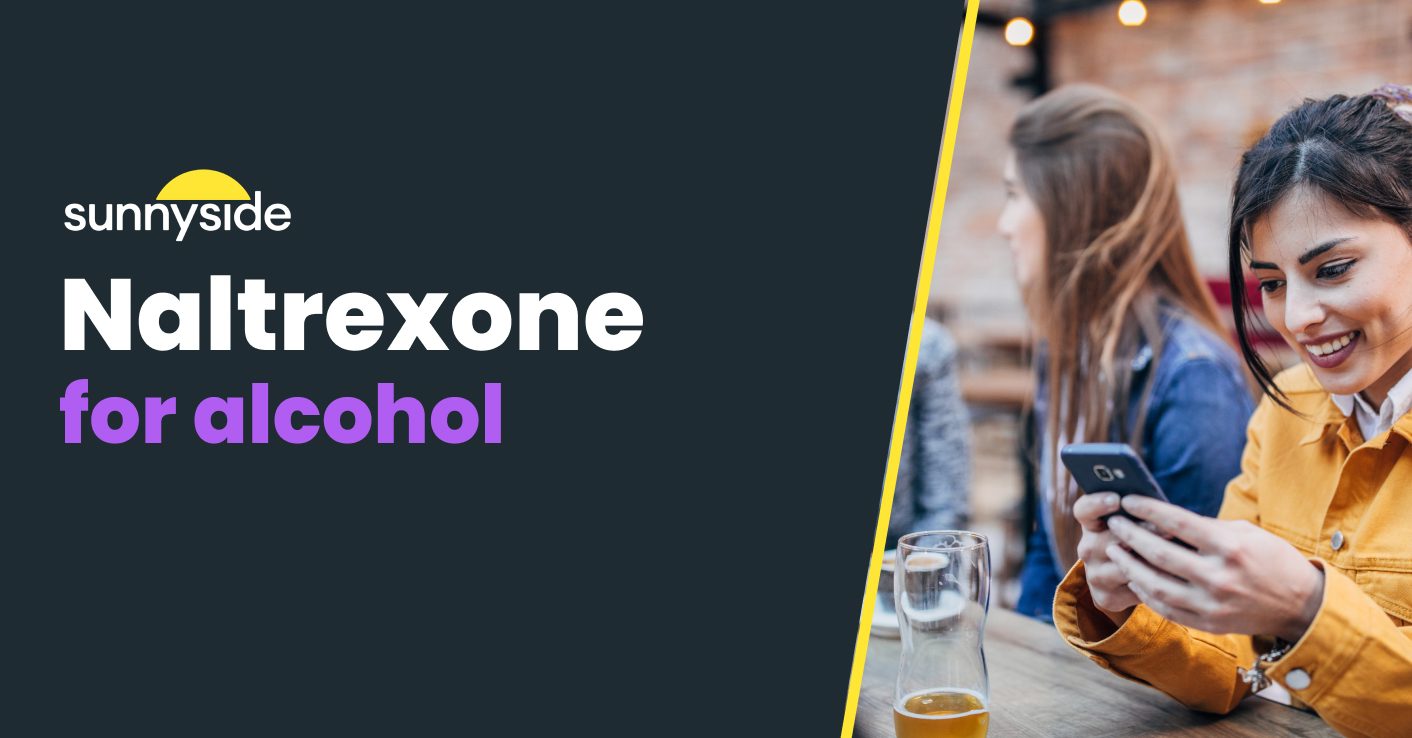Last Updated on April 25, 2025
One of the biggest myths around alcohol is that how much you drink is all about willpower.
In reality, drinking habits develop because your brain is doing what it’s been trained to do — seek out rewards. If alcohol becomes linked with relief, relaxation, or anything positive, your brain will eventually start craving it to get that dopamine hit.
So if you’re anxious, frustrated, sad, or just bored and following routine, it’s only natural that you would unconsciously reach for a drink. After, though, you might beat yourself up and not understand why it seems so hard to moderate. Except, it’s not weakness — it’s wiring.
This is where naltrexone for alcohol cravings comes in. It’s been used for decades to target automatic reward pathways. It helps curb drinking urges, giving you more space between craving and action to make a different choice.
Whether you’re looking to cut back on drinking or quit completely, naltrexone is a science-backed tool that might help you change your relationship with alcohol. Read on to learn how exactly it works, who it’s for, and what to expect if you try it.
What is Naltrexone?
Naltrexone is a prescription medication that works to retrain your brain’s response to alcohol. It’s designed to reduce cravings and give you more control over your drinking habits. You can take it as a daily pill (like with the brand Revia), making it easy to take and manage with few side effects.
It became an FDA-approved medication for alcohol use disorder (AUD) in 1994, but it can work for anyone looking to moderate or quit. You don’t have to have a classified drinking disorder to take advantage of it. If you just want to change your relationship with alcohol, it has the potential to work for you.
Unlike other medications, like Antabuse, taking naltrexone while drinking doesn’t make you sick. Instead, it works to make alcohol less appealing overall. The usual pull it has decreases, making it something you naturally start to crave less.
Learn more about Naltrexone in our comprehensive Naltrexone 101 guide
How Naltrexone Works in the Brain
Alcohol triggers the release of dopamine, your brain’s reward chemical. With everyone talking about ‘dopamine hits’ these days, you might already know it’s the chemical that makes almost any behavior that consistently gives you a reward addictive (just like social media). It’s dopamine firing off when you feel that first soothing, relaxing wave washes over you when you drink. Naturally, over time, your brain will start linking alcohol with relief, reinforcing the urge to drink.
Naltrexone steps in and helps reduce that craving by blocking your brain’s opioid receptors (where you release those feel-good chemicals). With those receptors blocked, alcohol can’t give you that same hit of relief, and then there’s no reinforcement if the pleasure isn’t there.
The result? Drinking becomes less rewarding. Cravings begin to fade. And your brain has a chance to unlearn the cycle it’s been stuck in.
This doesn’t happen overnight, but with regular use, naltrexone can weaken the connection between alcohol and reward, making it easier to break the habit.
Who Is It For?
Naltrexone is for anyone who wants to feel more in control of their drinking habits. If you feel like cravings are taking over or drinking is just something automatic instead of intentional, it might work well for you.
Something great about naltrexone is that it doesn’t have to be part of an all-or-nothing approach. It can be helpful if you want to moderate or quit completely (whether now or eventually). So if you’re struggling and feel like sobriety is your only option (which hasn’t worked in the past), naltrexone and moderation might work better for you.
Talking to Your Doctor About Naltrexone
If you’re curious to see if naltrexone is right for you, bring it up with your doctor. Let them know you’re interested in getting support to drink less or manage cravings, and that you heard naltrexone could be an option. If they aren’t familiar with it, services like telehealth providers and online programs can also work.
While it might feel intimidating or awkward to ask about it, it doesn’t have to be. The world is becoming much more open about mental health and the science behind drinking difficulties, taking the stigma off the person struggling. Naltrexone is quickly becoming a common medication for moderation and even off-label purposes, including binge eating and chronic pain.
What to Expect With Naltrexone
If you’re thinking about taking naltrexone for alcohol cravings, there are a few things to keep in mind.
First, it’s a relatively simple system where you take a pill daily, typically around 50 mg. However, there’s also the option to follow the Sinclair method, where you only take it on days you plan to drink. Specifically, at least a few hours before drinking.
Typically, naltrexone is recommended to be taken without any alcohol (abstinence). However, the neuroscientist Dr. David Sinclai realized that drinking while on naltrexone could also break the brain’s learned association. Since drinking won’t offer the same pleasure while on naltrexone, your brain can start associating alcohol without any benefit (making those hangovers feel extra not worth it). Over time, this can gradually take away the craving to drink.
Whichever method you choose, you can still expect an initial period where cravings are still there. It might take a week to notice some difference, and about 1-2 months for a stronger change, but it will be different for everyone.
Finally, you will be asked to go 3-7 days without alcohol before starting naltrexone to avoid withdrawal symptoms, side effects, and complications. It’s an important part of the process to make it more effective because the amount of naltrexone in your blood before drinking affects your response. So, if your naltrexone levels are too low and you start drinking, you might not notice any difference.
Potential Side Effects
Naltrexone is generally safe for most healthy people. Be sure to tell your health service provider of any health conditions or medications you’re on before starting naltrexone. In particular, it isn’t recommended for anyone with liver issues.
If you’re healthy and given the go-ahead by your doctor, some side effects you might notice include:
- Nausea (especially in the first few days)
- Headaches
- Dizziness
- Fatigue
Effectiveness: What the Research Says
Overall, naltrexone is largely viewed as an effective pharmacotherapy treatment for AUD — especially when used in combination with talk therapy (psychotherapy). For example, a large 2023 review of 118 clinical trials found that oral naltrexone significantly reduced heavy drinking when used with psychotherapy and support groups.
A 2016 review also found that daily naltrexone reduced alcohol consumption, the number of drinking days, and heavy drinking relapses. Even treatments of 12 weeks or less were linked to fewer drinks per day and total drinking days.
When it comes to studies on cravings specifically, participants reported that cravings were less intense. In this study, reduced cravings were found regardless of the severity of AUD. This suggests its helpfulness for people with less severe drinking difficulties.
Keep in mind that the majority of the studies on naltrexone for alcohol reduction included psychotherapy, making talk therapy an important piece that can’t be ignored. A safe space to learn helpful tools and strategies for managing habits and cravings is something that can lead to lifelong change.
Naltrexone and the Sunnyside Approach
Choosing naltrexone can be part of a science-backed decision to make changing your drinking habits more manageable. It’s a bit like using a meditation app to manage stress, or setting an alarm to remind you to wind down before bed. It’s one more tool that helps make change feel doable, especially when your habits have been running on autopilot for a while, and guilt or shame are taking over.
At Sunnyside, we believe in a whole-person approach to alcohol. That means combining medication, when helpful, with habit tracking, self-reflection, and expert coaching. Naltrexone pairs perfectly with this method, giving your brain space to reset while you build new routines and insights.
It’s not about giving up control — it’s about reclaiming it, with the right support behind you.
If you’re curious whether naltrexone might be a good fit, talk to your doctor. You don’t need a rock-bottom moment to ask for help. Sometimes the most powerful decision is simply deciding to try something new.




